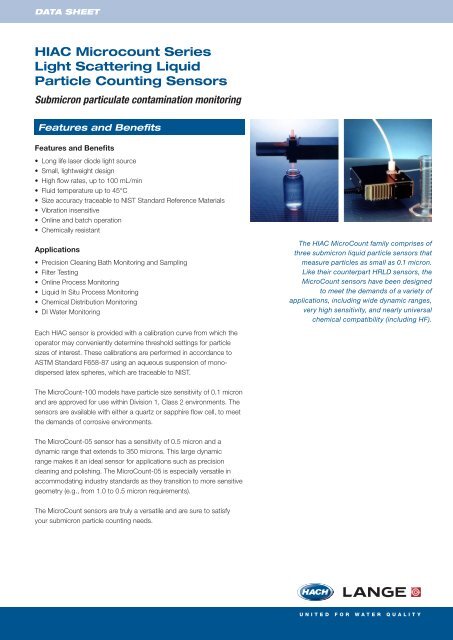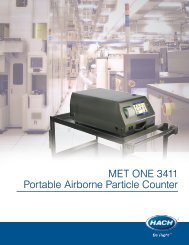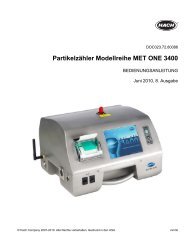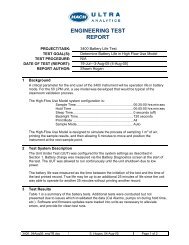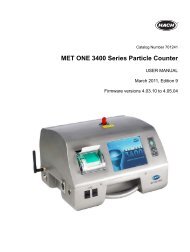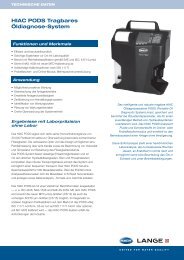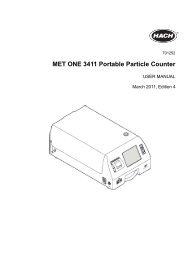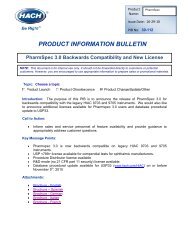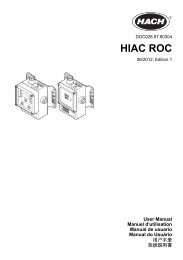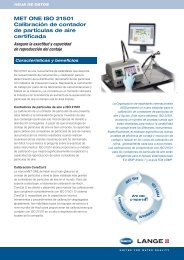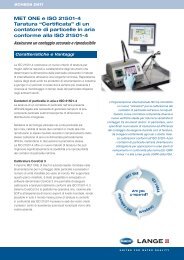HIAC Microcount Series Light Scattering Liquid Particle Counting ...
HIAC Microcount Series Light Scattering Liquid Particle Counting ...
HIAC Microcount Series Light Scattering Liquid Particle Counting ...
- No tags were found...
You also want an ePaper? Increase the reach of your titles
YUMPU automatically turns print PDFs into web optimized ePapers that Google loves.
DATA SHEET<strong>HIAC</strong> <strong>Microcount</strong> <strong>Series</strong><strong>Light</strong> <strong>Scattering</strong> <strong>Liquid</strong><strong>Particle</strong> <strong>Counting</strong> SensorsSubmicron particulate contamination monitoringFeatures and BenefitsFeatures and Benefits• Long life laser diode light source• Small, lightweight design• High flow rates, up to 100 mL/min• Fluid temperature up to 45°C• Size accuracy traceable to NIST Standard Reference Materials• Vibration insensitive• Online and batch operation• Chemically resistantApplications• Precision Cleaning Bath Monitoring and Sampling• Filter Testing• Online Process Monitoring• <strong>Liquid</strong> In Situ Process Monitoring• Chemical Distribution Monitoring• DI Water MonitoringThe <strong>HIAC</strong> MicroCount family comprises ofthree submicron liquid particle sensors thatmeasure particles as small as 0.1 micron.Like their counterpart HRLD sensors, theMicroCount sensors have been designedto meet the demands of a variety ofapplications, including wide dynamic ranges,very high sensitivity, and nearly universalchemical compatibility (including HF).Each <strong>HIAC</strong> sensor is provided with a calibration curve from which theoperator may conveniently determine threshold settings for particlesizes of interest. These calibrations are performed in accordance toASTM Standard F658-87 using an aqueous suspension of monodispersedlatex spheres, which are traceable to NIST.The MicroCount-100 models have particle size sensitivity of 0.1 micronand are approved for use within Division 1, Class 2 environments. Thesensors are available with either a quartz or sapphire flow cell, to meetthe demands of corrosive environments.The MicroCount-05 sensor has a sensitivity of 0.5 micron and adynamic range that extends to 350 microns. This large dynamicrange makes it an ideal sensor for applications such as precisioncleaning and polishing. The MicroCount-05 is especially versatile inaccommodating industry standards as they transition to more sensitivegeometry (e.g., from 1.0 to 0.5 micron requirements).The MicroCount sensors are truly a versatile and are sure to satisfyyour submicron particle counting needs.
SpecificationsSensitivity (μm) MicroCount-05 0.50MicroCount-100 0.10MicroCount-100S1 0.10<strong>Particle</strong> Size MicroCount-05 350.0 μm maximumMicroCount-100 5.0 μm maximumMicroCount-100S1 5.0 μm maximumView Volume MicroCount-05 90 ± 5%MicroCount-100 3%MicroCount-100S1 3%Flow Rate MicroCount-05 60 mL/minMicroCount-100 100 mL/minMicroCount-100S1 100 mL/minMax. Sample MicroCount-05 45°CMicroCount-100 45°CMicroCount-100S 45°CChemical Compatibility MicroCount-05 A, CMicroCount-100 A, CMicroCount-100S B, CSize MicroCount-05 9.75” w x 2.25” h x 2.5” d(24.8 x 5.7 x 6.4 cm)MicroCount-100 7.75” w x 2.18” h x 5.75” d(19.7 x 5.6 x 14.6 cm)Weight MicroCount-05 2 lbs (0.9 kg)MicroCount-100 5 lbs (2.25 kg)Calibration Standard calibration curves are shipped with eachsensor. Customer calibration is required for nonrecommendedsensor flow rates.HACH LANGE ServicesContact us to place an order,request information or receivetechnical support.Service packages and extendedwarranty up to 5 years.On site technical support.Seminars and workshops:Practical and hands on training.Regular customer informationby post and email.www.particle.comUp to date and secure, withdownloads, information ande-shop.A – Compatibility: All chemicals2, except HF acidB – Compatibility: All chemicals2C – Maximum Pressure: 150 psi (1034 kPa) water, 75 psi (517 kPa) chemicalWhen ordering, specifyMicroCount-100MicroCount-100SMicroCount-051 Sapphire cell construction2 Except for certain sodium compounds, interhalogen compounds, and ionized oxygen or peroxidesDOC062.52.20120.Dec11


